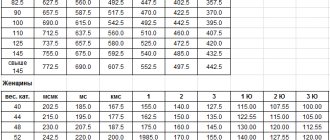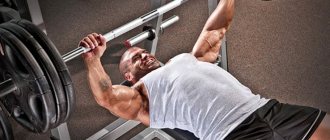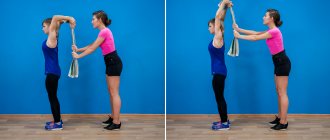Choosing a working weight to perform exercises is one of the key points to a successful workout. A low working weight will not allow the activation of muscle growth mechanisms, and an excessively high one will increase the risk of injury by reducing control over the technique.
In this case, the worst option would be to imitate famous athletes or random people from the gym. If someone does a biceps curl with 20kg dumbbells or bench presses with an 80kg barbell, that doesn't mean you need the same weight.
How to increase weight on a barbell (simulators)
To fully implement strength training programs, in addition to calculating the working and maximum weight, you need to know how to correctly increase the weight on the barbell . This is especially important at the initial stage, when the strength, and therefore the weight on the barbell, will grow very quickly, because a beginner is still very far from reaching the limit of the body’s hidden strength capabilities.
As soon as you feel that it is easy for you to carry out the set working weight in the exercise, or you are doing a heavy workout (6 repetitions) with a large margin, then in this case, you can safely increase the weight on the barbell by 2.5-5 kg . The main thing in this matter is not to rush , and the proverb “the slower you go, the further you will go,” shows the true picture of the upcoming future in increasing working weights on the barbell.
Slowly increasing the weight on the bar has a positive effect on the absence of injuries during training and on the correct execution of the exercise technique.
It is also necessary, especially at the initial stage of training, to keep a training diary in which you will record progress and regression in the exercises, that is, the number of approaches and repetitions performed, rest time , the feeling of fatigue after completing an approach and the working weight in a particular exercise.
How to increase weight on a barbell?
By recording the weight on the barbell and the date of the workout in your diary, you will be able to see and adjust the working weight in the future.
Now we know how much weight needs to be placed on the barbell (simulator), and what is the optimal number of approaches and repetitions to do in order to maximally involve muscle growth processes in the work.
All that remains is to choose the most effective exercises for muscle growth.
Weight selection during training
Having determined your training goal and your maximum, you can easily determine the working weights. After 2-3 weeks, as a rule, they can be slightly increased. Remember that strength decreases after a break in training for more than 2 weeks. After this time, the working weight should be reduced and the first training sessions are for 10-20 approaches per exercise. After several such sessions, return to your usual pattern.
Work for mass
Of course, strength training helps muscle mass grow. But often people need to increase the amount of muscle tissue, while increasing strength as such does not bother them. This most often occurs in fitness and bodybuilding. Then a safer load scheme with a slightly lower operating weight is used.
“If your goal is to gain mass,” says Olga Novikova, “take a weight of 75-80% of the maximum. Returning to the example with a barbell of 10 kg - 7.5-8 kg. You need to do 6-8 repetitions per set with it.”
When the number of repetitions reaches 10-12, you can either add working weight or start working on relief.
Endurance training
Not everyone trains to become very big or very strong. You can train at low intensity by choosing a weight relative to your one-rep max. This approach activates mechanisms in muscle fibers that make aerobic energy synthesis pathways more efficient, but does not increase muscle size. As a result, the muscles can perform many repetitions for a long time without fatigue. An example is the musculature of classic marathon runners, which is designed for continuous work over a long distance.
If your goal is muscular endurance, you should choose a light weight that will allow you to complete 15-20 or more repetitions. Such stimuli are not strong enough to increase strength or mass. This is because the muscles use slow-twitch muscle fibers, which are designed for long-term work and do not increase in volume the way fast-twitch muscles do.
What is working weight
Working weight is the weight of the weight that is used during exercise.
If it is chosen optimally, you can do a certain range of repetitions with it in the correct technique, after which muscle failure occurs (the inability of the muscles to perform the movement) or 1-2 repetitions remain before it.
For example, you need to squat with a barbell 10 times. If you choose the right working weight, you will only be able to do 10 repetitions. At rep 11, muscle failure will occur or you will be close to it. Further performance of the exercise without damaging the technique will be impossible.
Muscle volume training
Although those who train for maximum strength work with really heavy weights, their methods are not the best for maximizing muscle size (hypertrophy). Bodybuilders and gym goers who are looking to gain muscle mass take a slightly different approach to determining how much weight they should lift. The weight you can complete 8-12 reps with has been proven to produce the most muscle size.
But this statement requires some explanation, so let's start with that.
You must train with proper technique. You've probably seen videos on YouTube of guys doing bounce bench presses because the bar is too heavy and they have to use a little extra momentum to move it. This is not considered good technique. Each exercise contains its own “set of technical rules”. Generally speaking, you must control the apparatus and use only those joints that are destined to participate in this movement. If your biceps curl involves your knees or hips, you're using joints you shouldn't be using. There's a term for this—cheating—and it subverts the mantra of proper technique.
Perform “full” sets of 8–12 reps. Of course, you could just put a little less weight on the bar and stop at 12 reps, but that wouldn't be a full set. A full set ends on the verge of muscle failure - at the moment when you can no longer complete another repetition according to all the rules. If you can do 13 reps, you're using too light a weight. By analogy, if you can only do 4-5 reps, the load is too high for maximum muscle growth. The golden mean is a weight with which you can complete 8 to 12 repetitions without assistance.
Bodybuilders also train fast-twitch muscle fibers, usually starting with compound exercises divided according to body part. This technique requires a high volume of training load (3-4 working sets of compound exercises performed at various angles) and short rest periods (60 seconds for small muscle groups and 90 seconds for large muscles).
The golden mean is in the range of 8-12 repetitions











